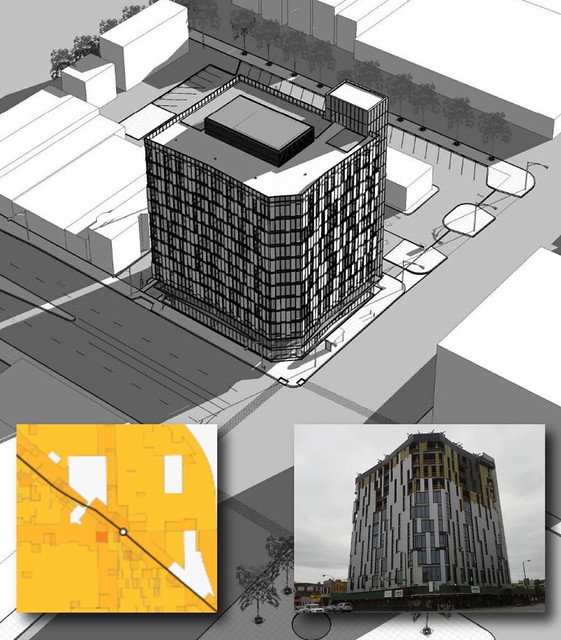
While I was browsing Andrew Salzberg's map showing how much development is allowed near transit stops, I noticed a dark spot -- a site where a taller building is allowed -- at the southwest corner of Ashland Avenue and Division Street. Then I remembered the development underway there, the "1601 Tower," on the site of a shuttered Pizza Hut restaurant. The interesting thing about this 11-story, 99-unit building is that it will provide no car parking spaces for residents.
Less off-street parking improves walkability by reducing the traffic generated by a building while minimizing curb cuts and other disruptions of the pedestrian environment. It also keeps housing more affordable, because, as the Chicago Metropolitan Agency for Planning puts it, "requiring large amounts of parking in new housing developments makes the housing more expensive...as the cost of parking is built into the cost of each unit." While the 1601 Tower could have been better -- the three ground-floor retail tenants will include a bank with a drive-through and will come with some parking spaces for customers -- a taller, mixed-use residential building with little parking, near transit, is definitely a step in the right direction.
The parcel was "upzoned" in 2012 to allow for a taller residential building than what's permitted in the surrounding area. In an email newsletter a year ago, 1st Ward Alderman Joe Moreno wrote: "This is exactly the kind of building that should be in this location, because of its proximity to the Blue Line. We had proposals for single-story commercial developments, which I rejected straight away." Curbed Chicago also credits the East Village Association for pushing for a parking-free development.
In siting the building so close to the 24-hour Blue Line, three higher-frequency bus routes (and a potential bus rapid transit route on Ashland), and the Division Street bike lane, developer Joe Buono made a city-friendly choice. He must feel confident the parking-free building will be able to lure future tenants in the highly-desirable neighborhoods of East Village and Wicker Park. Living car-free in the area is certainly possible: According to the U.S. Census, 16 percent of workers in the 60622 ZIP code don't have access to a car. Meanwhile, 4.4 percent bike to work; and 6.1 percent walk to work. (The citywide figures are 1.2 percent and 6.1 percent, respectively.)
Perhaps the owner of the next door Wendy's parcel will see the potential of that lot and convert it to a denser use.



